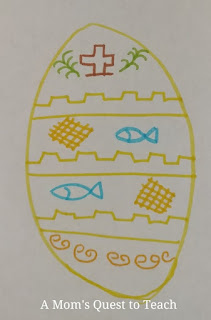My family has been decorating Easter Eggs since before I was
born. My grandpop was always the one in charge of the decorating of the eggs
with my mom, while my grandmom would handle the dying of the eggs with my help
when I was little. After my grandpop died, my mom and I continued the tradition
at our own home and now we shared it with my husband and three children.
The History
Eggs have long been associated with the source of life and
with the birth of Christianity. The symbol of the egg was likened to that of
the tomb of Jesus. Decorating both hard-boiled eggs and raw eggs was a
tradition among the Ukrainians during pagan times. When the people accepted Christianity in the
late 900s, the egg was adopted into the Easter celebration to break the fast of
Lent and was decorated with Christian symbols. The old pagan symbols were given
new life and new Christian meanings. For example, the sun designs now stood for
the Son of God, dots would come to present the tears of Mary, and the triangles
represented the Trinity.
There are two types of Ukrainian Easter eggs: the krashanky
(a hard-boiled egg which is dyed a solid color) and the pysanky (which is raw
egg that is decorated and dyed and not eaten). Most families today decorate and
dye only hard-boiled eggs but my family also used to decorate blown eggs.
(These were disposed of when I was little after one exploded in my grandparents’
living room. I guess it wasn’t properly prepared.)
There are many different legends about the origins of the
Ukrainian Easter Eggs. One tells of Mary, the mother of Jesus, preparing a
basket of eggs to take to Pontius Pilate while her son was imprisoned. Her
tears fell upon the eggs, creating the dots of many colors that are still drawn
on today. Another legend tells of a young woman who was returning home from the
market with her basket of eggs and jug of water. She came upon a man sitting on
a rock and offered him water. The stranger accepted her offer of water and she
went on her way. When she arrived at home, she discovered her eggs had
transformed into pysanky. The stranger was Jesus.
Natural Dyes
Yellow
|
Yellow onion skins (only soak for a short while)
Turmeric (bright yellow)
|
Yellow onion skins (check for color)
Chili powder (pale orange-buff)
|
|
Red
|
Beets
Red onion skins
|
Blue
|
Red cabbage leaves (light blue – less time; deep blue –
soak overnight)
|
Beige/Brown
|
Yellow onion skins (long soak)
Coffee
|
Decorating
The writing tool or stylus used for decorating the eggs with
melted wax is called a kistka (plural, kistky). My family always used an
un-sharpened pencil with a pin stuck into the eraser end. And I recommend
beeswax, as it is absorbed more readily into the pores of the egg so it
‘sticks’ to the egg better than man-made paraffin.
Safety Reminder! Melted beeswax is HOT. Do NOT allow young
children to participate. Do NOT leave them unattended around melted beeswax. In
my family, I was not allowed to participate in the actual decorating with
melted beeswax until I was 14 years old. We only recently allowed our teen to
start helping with this part of the egg-decorating process.
Designs
There are many different meanings for the various geometric
designs, plant designs, and animal designs.
 Many eggs will contain lines used for division that encircle
the entire egg. They can be thought of as symbolizing eternal life.
Many eggs will contain lines used for division that encircle
the entire egg. They can be thought of as symbolizing eternal life.
Nets and sieve designs have been found on pysanky long
before the egg was adopted as a Christian symbol. They can be linked to the
fisherman’s net as many of Jesus’ followers were fishermen and became fishers
of men.
Another symbol adopted by the Christians was the sun or star
to represent God. There are many variations upon this design.
Among the plant designs there are vines, roses, pine trees,
leaves, and wheat. Animal designs are not as easy to make as others due to the
small drawing surface but the fish, a symbol of Christianity, as well as
chickens, rams’ horns, deer, and horses have been drawn on the eggs.
Of course, there are many other cultures and countries that
also dye and decorate Easter eggs including Russia ,
Serbia
I used our Magic Stix Washable Markers to create the designs on paper this year!
I linked up with the following blog(s):










That is a very neat way to do Easter eggs. I wonder if crayons would the tip slightly melted would work with children....
ReplyDeleteI know that the crayons you get with the Paas dye kits never work really well. I think there is something about the beeswax that really helps it stick.
Deletethat's good to know. it is a different wax.
DeleteI wonder if I can get the lad to try this with me this year...
ReplyDelete